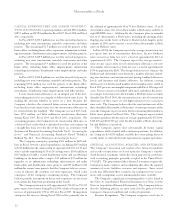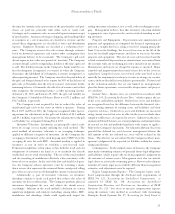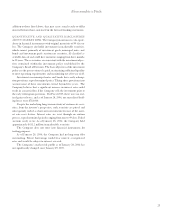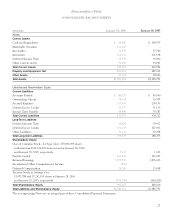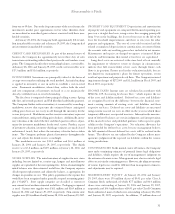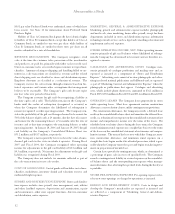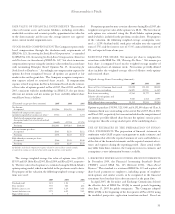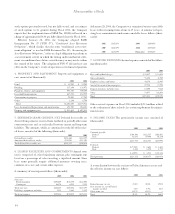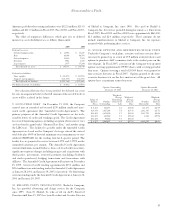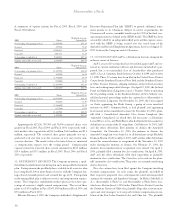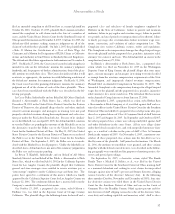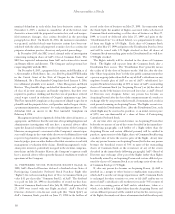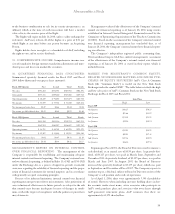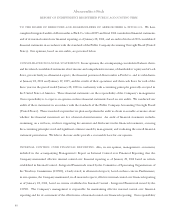Abercrombie & Fitch 2005 Annual Report Download - page 32
Download and view the complete annual report
Please find page 32 of the 2005 Abercrombie & Fitch annual report below. You can navigate through the pages in the report by either clicking on the pages listed below, or by using the keyword search tool below to find specific information within the annual report.
Abercrombie &Fitch
30
1. BASIS OF PRESENTATION Abercrombie & Fitch Co. (“A&F”),
through its wholly-owned subsidiaries (collectively, A&F and its whol-
ly-owned subsidiaries are referred to as “Abercrombie & Fitch” or the
“Company”), is a specialty retailer of high quality, casual apparel for
men, women and kids with an active, youthful lifestyle. The business
was established in 1892.
The accompanying consolidated financial statements include the
historical financial statements of, and transactions applicable to, A&F
and its wholly-owned subsidiaries and reflect the assets, liabilities, results
of operations and cash flows on a historical cost basis.
FISCAL YEAR The Company’s fiscal year ends on the Saturday clos-
est to January 31. Fiscal years are designated in the financial statements
and notes by the calendar year in which the fiscal year commences. All
references herein to “Fiscal 2005” represent the results for the 52-week
fiscal year ended January 28, 2006; to “Fiscal 2004” represent the 52-
week fiscal year ended January 29, 2005; and to “Fiscal 2003” represent
the 52-week fiscal year ended January 31, 2004. In addition, references
herein to “Fiscal 2006” represent the 53-week fiscal year that will end on
February 3, 2007.
RECLASSIFICATIONS Certain amounts have been reclassified to
conform with the current year presentation. Amounts reclassified did
not have an effect on the Company’s results of operations or total
shareholders’ equity. On the Consolidated Balance Sheet for the year
ended January 29, 2005, the Company reclassified (a) deferred income
tax assets ($44.4 million) that were previously netted against income
tax payable to current assets; (b) the long-term portion of straight-line
rent ($32.9 million) from an accrued expense to other long-term liabil-
ities and the corresponding deferred income tax asset ($13.2 million)
from current to long-term deferred income taxes; (c) the long-term
portion of executive severance ($6.6 million) from accrued expense to
other long-term liabilities; (d) the portion of gift card liabilities ($10.4
million) that was previously classified in other long-term liabilities to
accrued expense; (e) a portion of store supplies ($20.6 million) from
current assets to other non-current assets and the corresponding
deferred income tax liability ($7.8 million) from current to long-term
deferred income taxes; (f) deferred compensation ($15.0 million) to be
shown as a separate component of shareholders’ equity; and (g) third-
party credit card receivables ($11.6 million) from cash equivalents to
receivables. On the Consolidated Statements of Cash Flows, the
reclassification of third-party credit card receivables during Fiscal 2004
and Fiscal 2003 decreased the ending cash balance and other assets and
liabilities by $11.6 million and $9.3 million, respectively. All other
reclassifications were within the operating activity section of the
Consolidated Statements of Cash Flows.
Beginning with the first quarter of the fiscal year ending January 28,
2006, the Company reclassified the condensed consolidated statements
of net income and comprehensive income. In prior periods, the
Company included buying and occupancy costs as well as certain home
office expenses as part of the gross profit calculation. The Company
believes that presenting gross profit as a function of sales reduced sole-
ly by cost of goods sold, as well as presenting stores and distribution
expense and marketing, general and administrative expense, as individ-
ual expense categories, provides a clearer and more transparent repre-
sentation of gross selling margin and operating expenses. Prior period
results have been reclassified accordingly.
SEGMENT REPORTING In accordance with Statement of
Financial Accounting Standards (“SFAS”) No. 131, “Disclosures about
Segments of an Enterprise and Related Information,” the Company
determined its operating segments on the same basis that it uses inter-
nally to evaluate performance. The operating segments identified by
the Company, Abercrombie & Fitch, abercrombie, Hollister and
RUEHL, have been aggregated and are reported as one reportable
financial segment. The Company aggregates its operating segments
because they meet the aggregation criteria set forth in paragraph 17 of
SFAS No. 131. The Company believes its operating segments may
be aggregated for financial reporting purposes because they are simi-
lar in each of the following areas: class of consumer, economic char-
acteristics, nature of products, nature of production processes and dis-
tribution methods.
2. SUMMARY OF SIGNIFICANT ACCOUNTING POLICIES
PRINCIPLES OF CONSOLIDATION The consolidated finan-
cial statements include the accounts of A&F and its subsidiaries. All
intercompany balances and transactions have been eliminated in con-
solidation.
CASH AND EQUIVALENTS Cash and equivalents include
amounts on deposit with financial institutions and investments with
original maturities of less than 90 days. Outstanding checks at year-end
are reclassified in the balance sheet from cash to accounts payable to
be reflected as liabilities.
MARKETABLE SECURITIES Investments with original maturi-
ties greater than 90 days are accounted for in accordance with SFAS
No. 115, “Accounting for Certain Investments in Debt and Equity
Securities,” and are classified accordingly by the Company at the time
of purchase. At January 28, 2006, the Company’s investments in
marketable securities consisted primarily of investment grade municipal
notes and bonds and investment grade auction rate securities, all classified
as available-for-sale and reported at fair value, with maturities that could
range from three months to 40 years.
The Company began investing in municipal notes and bonds dur-
ing Fiscal 2005. These investments have early redemption provisions
at predetermined prices. For the fiscal year ended January 28, 2006,
there were no realized gains or losses and as of January 28, 2006, net
unrealized holding losses were $718,000.
For the Company’s investments in auction rate securities, the interest
rates reset through an auction process at predetermined periods ranging
NOTES TO CONSOLIDATED FINANCIAL STATEMENTS




